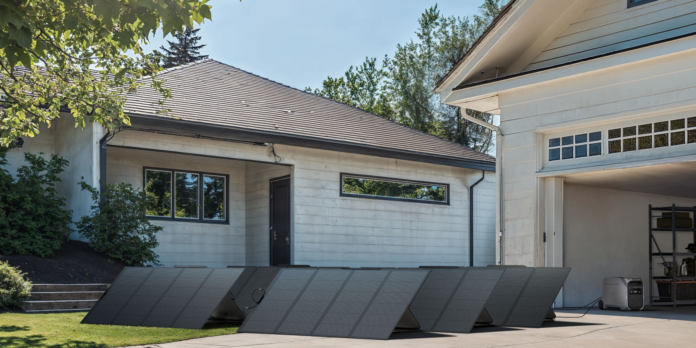Table of Contents
Solar irradiance describes the energy received from the Sun per unit area measured. It can also be thought of as the power density received on a surface, typically measured in watts per square meter.
Understanding what this means is essential for anyone considering solar power, as it impacts how much energy your system can generate. Geographic location, time of day, and weather conditions influence how much energy a surface receives.
Let’s explore solar irradiance in-depth, including how we measure it and why it’s crucial for determining the optimal placement of solar panels, also called photovoltaics or PVs.
Types of Solar Irradiance
Solar irradiance comes in different forms because electromagnetic radiation from the Sun doesn’t hit all surfaces uniformly. Every location on Earth receives sunlight, although in high latitudes, that might only be for part of the year. Therefore, the energy received naturally varies with geographic location, time of day, seasons, weather, and local factors like mountains, valleys, trees, etc.
Also, because the Earth is round and rotates daily on its axis, the sun strikes the surface at angles ranging from 0° just above the horizon to directly overhead at 90°. When the sun’s rays are perpendicular to the surface, called peak sunlight hours, that surface gets the maximum amount of energy it can. Outside peak sunlight hours, the rays become longer and slanted and are more scattered and diffused through the atmosphere.
It’s essential to understand the pros and cons when choosing your own photovoltaic system. PVs work best when the sun is directly overhead, and their efficiency will be very low if they only get diffused light. When buying your solar generator, consider peak sunlight, shading by buildings and trees, roof style, and whether your location gets plenty of DNI or more DFI, which we will explore next.
Direct Normal Irradiance (DNI)
Direct Normal Irradiance, or DNI, represents the amount directly received from the Sun perpendicular to the surface. It’s electromagnetic radiation that reaches the Earth’s surface without any obstructions or scattering from the atmosphere.
DNI is measured in watts per square meter (W/m²), and this type is critical for concentrated solar power (CSP) systems, which use mirrors or lenses to concentrate the incoming light onto a receiver. It is also essential in efficient photovoltaic systems.
Diffuse Horizontal Irradiance (DHI)
Diffuse Horizontal Irradiance, or DHI, is electromagnetic radiation that arrives at the Earth’s surface after being scattered or diffused by the atmosphere and clouds. As a result of scattering, it arrives from all directions, making it less efficient in solar applications. DHI is also measured in watts per square meter (W/m²).
Global Horizontal Irradiance (GHI)
Global Horizontal Irradiance, or GHI, is the total electromagnetic radiation received on a horizontal surface. It can be defined as the sum of DNI + DHI = GHI.
GHI is the easiest to measure and is also typically measured in W/m². It’s widely used when designing photovoltaic systems to determine the best placement and evaluate the performance of those already installed.
How Is Solar Irradiance Measured?
It can be easily measured using a meter, often called a pyranometer, that measures the total solar radiation, GHI, that hits its flat surface from a 180-degree field of view. A pyrheliometer can be used for more precise measurements of only DNI.
Alternatively, if complete accuracy is unnecessary, most smartphones can utilize apps to measure GHI. While some apps can be reasonably accurate, they’ll vary with the phone’s age and quality.
How To Calculate Solar Irradiance
Determining solar irradiance requires rather complex calculations to determine the amount of energy received per unit area, usually a square meter. The calculations require values for the angle of the sun over the surface, the distance between the Earth and the Sun, and the solar constant, which is the amount of incoming solar radiation measured at the outer atmosphere, about 1361 W/m². Although calculations can be complex, plenty of easy-to-use online tools can do them for you.
Solar Irradiance & Panel Placement
The amount of energy a photovoltaic panel can generate is directly proportional to the solar irradiance it receives, which is at a maximum when directly overhead at peak sunlight.
Therefore, it’s essential to install your EcoFlow Rigid Photovoltaic Panels in a position that maximizes the amount of peak sunlight you get. This is determined by your geographic location as well as local conditions like shade from trees or buildings.
Under most circumstances, EcoFlow 400W Rigid Solar Panels are best for rooftop or ground-based residential applications. These highly durable and efficient models can be mounted on angles that allow you to maximize their exposure to peak sunlight. Talk to your photovoltaic installer if you have questions about proper placement. Also, don’t forget to take advantage of the great federal tax credits when you purchase your new system.
If you have a particularly tricky roof or shade situation, consider using EcoFlow Portable Photovoltaic Panels. These panels can be moved around in different seasons or at different times of day to better optimize your available sunlight.
Frequently Asked Questions
Solar radiation is a broad term that means all radiation we receive from the Sun. Irradiance, on the other hand, is a measure of the amount of incoming electromagnetic radiation, diffuse and direct, as it lands on a horizontal surface.
On a clear day at sea level, the maximum irradiance is around 1000 W/m2, which is what is used to test photovoltaics in laboratory conditions. However, in the real world, anything over about 300 W/m2 is generally considered good.
Final Thoughts
Solar irradiance plays a critical role in determining the placement of photovoltaic panels and their resulting efficiency. By understanding the types of irradiance—Direct Normal Irradiance (DNI), Diffuse Horizontal Irradiance (DHI), and Global Horizontal Irradiance (GHI)—we can make informed decisions about where to place our panels to maximize our energy output.
For instance, EcoFlow Photovoltaic Panels are highly efficient when properly installed and provide a long-lasting solution for renewable power generation.
